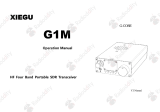
P/N: 3100559 REV: 3.0 07OCT05 Installation Sheet
2 / 2 Genesis Strobe
Agency listings: Meets year 2004 UL requirements for
standards UL1638 and UL1971 (see Figure 1) and
Canadian requirements for standards CAN/ULC S526-02
and CAN/ULC S524-01
UL ratings: Regulated 24 DC, Regulated 24 FWR
ULC ratings: 20 to 31 Vdc or 20 to 31 Vfwr
Table 3: Strobe operating current in RMS (A)
15 cd 30 cd 75 cd 110 cd
16 Vdc 0.103 0.141 0.255 0.311
16 Vfwr 0.125 0.179 0.346 0.392
Vdc = Volts direct current, regulated and filtered
Vfwr = Volts full wave rectified
100
95
90
85
80
75
70
65
60
55
50
45
40
35
30
25
20
15
10
5
0
5
10
15
20
25
30
35
40
45
50
55
60
65
70
75
80
85
90
95
100
0
5
10
15
20
25
30
35
40
45
50
55
60
65
70
75
80
85
90
-5
-10
-15
-20
-25
-30
-35
-40
-45
-50
-55
-60
-65
-70
-75
-80
-85
-90
Angle
Percentage of rated output
Horizontal and vertical outputs reflect the same pattern.
Figure 1: UL 1971 minimum light output (% of rating vs. angle)
Installation instructions
Warning: To reduce the risk of shock, disconnect all power
and allow 10 minutes for stored energy to dissipate before
handling.
Caution: Electrical supervision requires the wire run to be
broken at each terminal. Do not loop the signaling circuit field
wires around the terminals.
To install the strobe:
1. Remove the cover by depressing both tabs on the top of
the unit with a small screwdriver and twisting slightly.
2. Slide the candela switch to the desired candela output (15,
30, 75, or 110 cd) by aligning it with the indicator located
beside the switch. See Figure 2.
3. Set the strobe signal if required. See Figure 3.
4. Connect the strobe terminals to the signal circuit field
wiring. You must observe polarity for the unit to function
properly. See Figure 4.
5. Mount the unit onto a compatible electrical box, making
sure not to over-tighten the mounting screws.
6. Replace the cover by aligning at the bottom, then
snapping in at the top.
7. Test the unit for proper operation.
110
75
30
15
Figure 2: Candela switch
J2
J3
J1
To change the strobe to
temporal (private mode) cut
from circle J1 to edge of circuit
board
Figure 3: Strobe signal setting
Note: If the strobe is set to temporal (private mode), this
device is no longer UL 1971 listed and FM Approved but is UL
1638 listed.
Note: Polarity shown in alarm condition
To next device or
end of line device
-
+
-
+
From compatible fire
alarm control panel
+
-
+
-
Figure 4: Wiring diagram
Maintenance
This unit is not serviceable or repairable. Should the unit fail to
operate, contact the supplier for replacement.
Perform a visual inspection and an operational test twice a
year or as directed by the local authority having jurisdiction.






